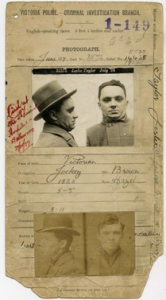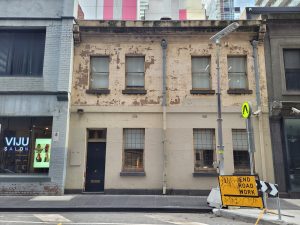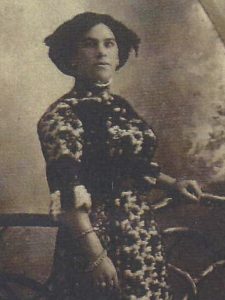Archaeology at Old Melbourne Gangster’s House, The Squizzy Taylor Dig
Client: Kennon Architects
Location: 120-122 Little Lonsdale Street, Melbourne
Date: 2024, ongoing
Services Provided
- Heritage Impact Statement (HIS)
- Historical archaeological excavation
- Historical Consent
- Artefact analysis and reporting
- Artefact conservation
Background
Biosis was commissioned by Kennon Architects to undertake a Heritage Impact Statement (HIS) and Excavation at the former house of infamous Melbourne gangster Leslie ‘Squizzy’ Taylor.
The house at 120-122 Little Lonsdale Street was his home from 1915 to 1920. During a period of sly grog shops and the Fitzroy Vendetta. After obtaining the Consent to Excavate issued by Heritage Victoria, the Biosis heritage archaeology and historical consultant team, were naturally excited to begin trenching within the property.
Urban heritage listed properties around Little Lonsdale Street can offer important insight into the lives of the working class, and the entertainment district, of 19th Century Melbourne.
Leslie Squizzy Taylor
Squizzy is probably Melbourne’s most well-known gangster of the inter-war period; the post-war and depression era gang-rivalry of inner-city Melbourne was, to say the least, cut-throat and neighbouring suburb Fitzroy was its heart.
His crimes included armed robbery, drug trafficking, race fixing, prostitution, and jury rigging. He was linked to several high-profile and violent crimes, including the murder of a police constable and robbery at Trades Hall, the murder and robbery of commercial traveller, Arthur Trotter, and the armed hold-ups and murder of two bank managers in Bulleen and Glenferrie.
In 1919, a dispute over gangland territory resulted in the ‘Fitzroy Vendetta’ shootings. During the same period, he was living at 122 Little Lonsdale Street.

Photo of Taylor from Victorian prison register
Archaeologically Rich Location
120-122 Little Lonsdale Street forms part of a very complex archaeological site, where surrounding properties have uncovered some of the most intact and fascinating remains of early Melbourne and what was known as the Little Lon ‘entertainment’ district.
Additionally, there is evidence that the site was once occupied by notorious Melbourne gangster Leslie ‘Squizzy’ Taylor and his wife Dolly Gray. Squizzy and Dolly occupied the residence from 1915 to 1920 and ran their operations for control over Melbourne’s gangland wars, erupting across the city. They also ran their illegal brothel and bottle shop from this location, based on police records. It is also believed that Dolly played an active role in many of Squizzy’s crimes, especially those crimes where he used to extort money from married men.

120-122 Little Lonsdale Street facade
According to the Argus, Dolly Gray ran a well-known sly grog operation from 122 Lonsdale Street.
“.. These premises and the adjoining premises, 122 Little Lonsdale Street are occupied by Dolly Gray who is living with the notorious Leslie Taylor. The soldiers broke in the front door of 120 Little Lonsdale Street, and when we arrived with Constables Fennessey and McCaffrey, the soldiers were saying to Dolly Gray “This is a sly grog shop and you met us in Lonsdale Street today and you told us, this number – ‘120’ – and said we could get plenty of beer up here at one shilling and sixpence a bottle”. Dolly Gray said “You have made a mistake boys.” We ordered them off and after some whispered conversation with Dolly, the ringleaders said “Yes. We have made a mistake and are sorry.” They fell in and one of them called out “Quick march to Fitzroy. We can get plenty of beer out there”, and they all marched off towards Fitzroy (The Argus, 3 November 1917, p.6).

Dolly Gray (Kelly, 2022)
The Excavation Outcome
During the historical heritage excavations at 122 Little Lonsdale Street, evidence of Squizzy and Dolly’s occupation as illicit liquor merchants was uncovered by Biosis archaeologists; along with it their social confidence as kingpins of Melbourne’s underworld.
Champagne bottle tops were found in remarkable quantities at the rear courtyard of Squizzy and Dolly’s home. Their original bottles were not carefully uncorked, but joyously sabred, many of them revealing a clean separation between the neck and lip, as if each evening at Squizzy and Dolly’s house a raucous party unfolded: champagne bottles raised, their necks broken precisely, the tops flying across the room, and glasses of bubbly poured forth.
Biosis historical archaeologist Sam Dix suggests their confidence as two of Melbourne’s most notorious underworld figures is evidenced by their adoption of the upper-class habit of sabred champagne bottles.
Traditionally the working class drank bottles made of stone and consumed them behind closed doors, at odds with the bottles uncovered at 122 Lonsdale Street.
In early 20th-century Melbourne, the ceremonial technique for opening a sparkling wine bottle during a celebration at a fine establishment was to strike it with a sharp knife or similar implement (historically with a sword). This art of ‘sabrage’ was intentionally dramatic and required fine-tuning to avoid shards of glass dropping into the champagne, and the method was no doubt honed by those wealthy enough to do it regularly.
It seems Squizzy had truly mastered the art form and revelled in this symbol of social opulence.

Champagne bottle recovered at the site

Top of a champagne with wire and cork remains
Fitzroy Gangs
While residing at 122 Little Lonsdale Street, which is in the heart of inner-city Melbourne, one of the bloodiest periods of Squizzy’s reign occurred. It was known historically as the ‘Fitzroy Vendetta’, where rivalry attacks between Squizzy’s Push (gang) from Richmond and the Fitzroy Push escalated in 1919.
Fitzroy, the suburb north of Melbourne’s inner city, was a hot spot for ‘after 6’ sly grog shops, brothels, and cheap boarding houses, attracting all classes of wealth eager for nefarious entertainment, and attracting the gangsters who sought market control.
Fitzroy Vendetta 1919
The trigger for the Fitzroy Vendetta in 1919 is varied, as there were several stand-offs between the Fitzroy Push and Squizzy Taylor’s Richmond Push before a documented assault on Dolly. However, Dolly is often cited as a major trigger. She attended an underworld party in Fitzroy in 1919, adorned with jewellery from an earlier robbery that Taylor had orchestrated, and was then robbed of £200 worth of jewellery and attacked, left to return in just her underwear.
The subsequent revenge attacks on members of the Fitzroy gang continued for years and cemented his position as top dog in Melbourne’s true crime history of the City (while also paving the way for his eventual death in a dramatic Fitzroy shootout with Snowy Cutmore in 1927).
The Fitzroy Vendetta marked the end of the relationship between Dolly and Squizzy. Dolly soon left her Little Lonsdale Street address and moved to Adelaide.

Artefacts uncovered at 120-122 Little Lonsdale Street
More details of the post-excavation analysis will be published later, so watch this space!
